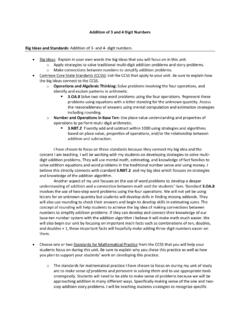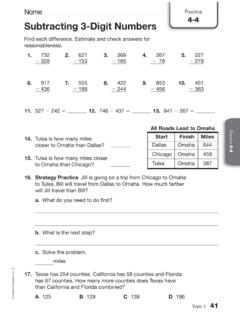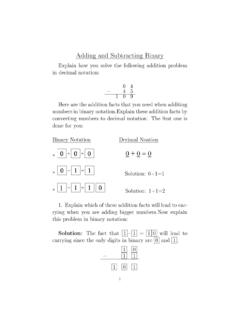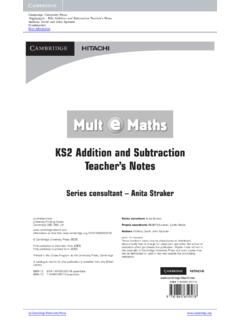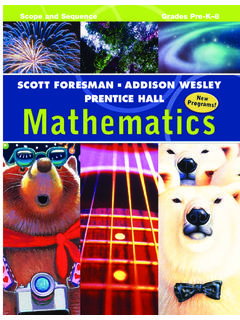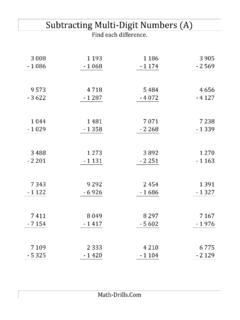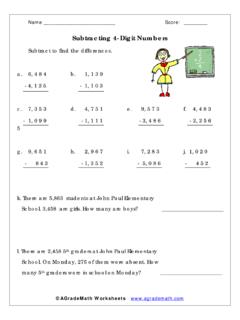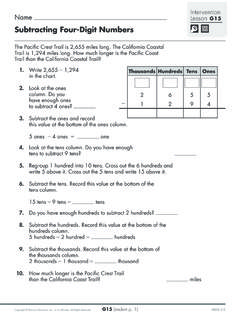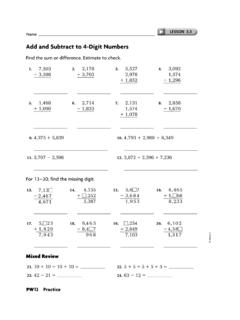Transcription of Module 8 SUBTRACTION OF WHOLE NUMBERS - AMSI
1 SUBTRACTION OF WHOLE NUMBERSSSSUBTRThe Improving Mathematics Education in Schools (TIMES) Project number AND ALGEBRA Module 8 A guide for teachers - Years 4 7 June 2011 SUBTRACTION of WHOLE NUMBERS ( Module 8: number and Algebra)For teachers of Primary and Secondary Mathematics510 Cover design, Layout design and Typesetting by Claire HoThe Improving Mathematics Education in Schools (TIMES) Project 2009 2011 was funded by the Australian Government Department of Education, Employment and Workplace views expressed here are those of the author and do not necessarily represent the views of the Australian Government Department of Education, Employment and Workplace Relations.
2 The University of Melbourne on behalf of the International Centre of Excellence for Education in Mathematics (ICE EM), the education division of the Australian Mathematical Sciences Institute (AMSI), 2010 (except where otherwise indicated). This work is licensed under the Creative Commons Attribution NonCommercial NoDerivs Unported License. nc BrownMichael EvansDavid HuntJanine McIntoshBill PenderJacqui RamaggeSSSubtrSubtraction of WHOLE nuNberSSubtracion fWthleubale Nmts(MNle oft ftdNuoo8mt:SrhsdAtgio)bNetSubtraciSocin rtaic Module 8 Subtracuionu cfWhcnlueuNcfnlums(SubtraciiSUBTRACTION OF WHOLE NUMBERS {4}A guide for teachersASSUMED KNOWLEDGE An understanding of the Hindu Arabic notation and place value as applied to WHOLE NUMBERS (see Module Counting and Place Value).)
3 An appreciation that SUBTRACTION can be modelled by removing objects from a set of objects, and also by a difference in sizes of two sets of objects. Familiarity with the use of the number line to model addition, as well as SUBTRACTION both as difference and as taking away. Counting forwards and backwards by ones and skip counting on the number line. Understanding of, and fluency with, addition. Fluency with the calculation of all subtractions involving WHOLE NUMBERS up to and including 18. The use of complementary addition to perform simple subtractions . For example, for 15 7 = 8 , we recall 7 + 8 = the four arithmetic operations on NUMBERS , addition is the most natural and, historically, was the first operation developed.
4 SUBTRACTION and addition are inverse operations. For example 60 3 = 57 is equivalent to 60 = 57 + answers questions such as: 1 A class has 30 students and 16 of them are girls. How many boys are there in the class?2 I have $100 and I spend $20. How much do I have left? 3 Terry has 11 chocolates and Marie has 7. How many more chocolates does Terry have?These questions are examples of three different types of question that require SUBTRACTION for their solution. A way of classifying questions that require SUBTRACTION for their solution is addressed in the Content section.{5}The Improving Mathematics Education in Schools (TIMES) ProjectCONTENTTHE ADDITION TABLEIt is essential that students can do all the subtractions implicit in the addition table for two single digit NUMBERS .
5 +012345678900123456789112345678910223456 7891011334567891011124456789101112135567 8910111213146678910111213141577891011121 3141516889101112131415161799101112131415 161718 Before moving on to SUBTRACTION algorithms, students need to be fluent in all subtractions for which the addition table of single digit NUMBERS provides the complementary additions. For example, both 13 5 = 8 and 13 8 = 5 have the complementary addition 13 = 8 + ask students to develop fluency with addition and SUBTRACTION involving WHOLE NUMBERS up to and including 20 (instead of 18 as is done in the addition table) because it is useful to learn and because fluency aids calculations.{6}A guide for teachersDIFFERENT WAYS OF THINKING ABOUT SUBTRACTIONThe following three questions illustrate three types of questions that require SUBTRACTION for their Matthew is riding his bike to the shopping centre 18 kilometres away.
6 He gets a flat tyre after travelling 13 kilometres. How much further is it to the shopping centre? We calculate the missing part as 5 kilometres. 2 Jenny has ten apples in a bowl and gives three apples to Fred. How many apples does Jenny have left? To solve this we think of taking three away from ten and conclude that Jenny has seven apples Harry is 123cm tall and Ally is 112cm tall. How much taller is Harry than Ally? We calculate the difference between Harry s height and Ally s height and conclude Harry is 11cm taller than Ally or Ally is 11 centimetres shorter than three questions given above, and the three questions in the Motivation section, are examples of three different types of situations where subtractions arise.
7 These are sometimes called:1 Part WHOLE (or adding on): A part of a set or quantity is specified and it is required to find how much is needed to make it WHOLE .2 Take away: Objects are removed from a set or a measurement is decreased by a specified Difference: Two sets or two measurements are compared. In this case SUBTRACTION is interpreted as number LINE AND subtractions ubtracting by taking away If you have 5 items and you take 2 away, the number remaining is 5 2, which is 3. For example, I had 5 pencils but my sister took 2 away, so now I have 3 .In this case, 2 is subtracted from 5 to give 3. On a number line, this can be illustrated as 2 = 3 With larger NUMBERS this might be done by counting backwards (to the left) by ones or taking the correct number of steps to get to the solution.
8 {7}The Improving Mathematics Education in Schools (TIMES) ProjectSubtracting by adding on Another way of thinking about the SUBTRACTION 5 2 is to ask What do you add to 2 in order to get to 5? This can also be illustrated on the number + 3 = 5 so 5 2 = 3 One example of this is I have 5 pencils and my brother has 2, so I have 3 more pencils than my brother .With larger NUMBERS we might count forwards (to the right) by ones the number of steps to get to the number we want. The solution is the number of steps we took. When we think of SUBTRACTION in this way, we are using complementary STRATEGIES FOR SUBTRACTIONOur choice of approach for SUBTRACTION depends on the NUMBERS involved.
9 We usually calculate 20 17 using complementary addition, whereas we calculate 20 3 directly by taking away. Both correspond to the same addition fact, 20 = 17 + students start using an algorithm, they might be less likely to develop new mental strategies. It is therefore important that students are given the opportunity to develop a variety of useful mental strategies before a standard algorithm is digit SUBTRACTION with no change to columns When a student sees 68 5, they must recognize that the mental calculation is not much more complicated than 8 5 and conclude that 68 5 = 63. In doing so, they are mentally decomposing 68 and calculating 68 5 = 60 + (8 5) = 63 Decomposition is a basic component of all SUBTRACTION digit SUBTRACTION with change to columns Students should be asked to consider calculations such as 62 5 = 57 and be encouraged to perform the SUBTRACTION in different ways, including: Counting backwards and keeping track of the steps.
10 For example, 57 58 59 60 61 62 Breaking the number apart into manageable steps. For example, 62 5 = 62 2 3 = 60 3 = 57 A different decomposition. Would be, 62 5 = 50 + (12 5) = 57{8}A guide for teachersSubtraction by equal additionThe principle of equal addition is the observation that if you add the same amount to two NUMBERS , their difference does not change. In the example, 37 18 = 39 20 = 19, we have added 2 to both 37 and 18 to make the calculation that the principle of equal addition also tells us that if you subtract the same amount from two NUMBERS their difference doesn t change. This can be used in a mental SUBTRACTION such as 115 65 = 100 50 = 50 or 115 65 = 110 60 = 1 Discuss the different mental strategies for performing the following subtractions .



